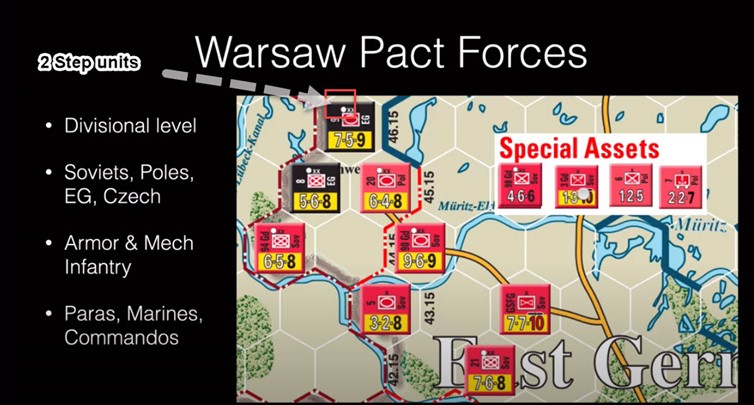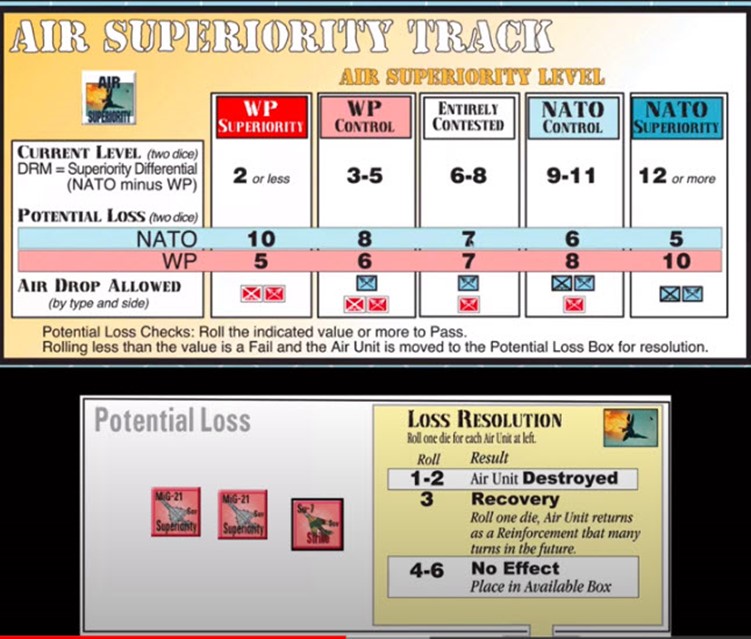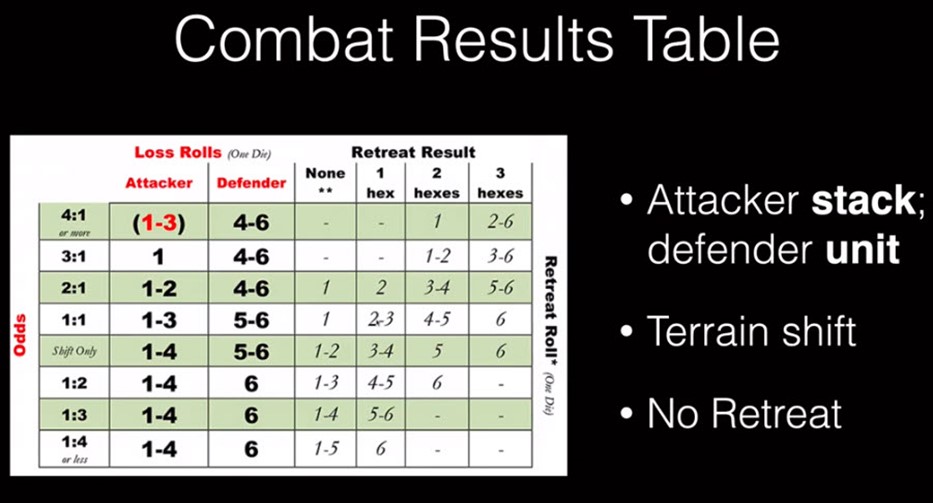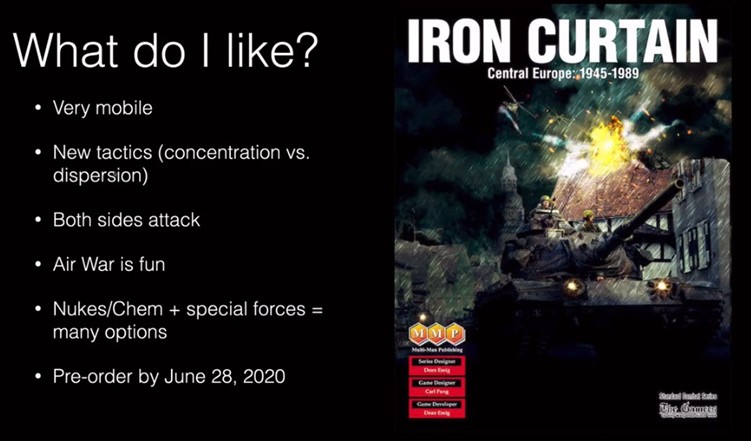Lee Forester walks through his thoughts on his Pre Release access to Carl Fung’s SCS Modern War design.
Will the SCS system play nice with Modern Warfare? Lee breaks his video up into some buckets. The link to his video is at the end of this brief article. For those that want the capsule comments here is my take on Less vid:
First Section:
War Run Up-

Each Scenario is 10 turns of 3 days per turn & 15 miles per hex.
Pre War- movement/no attacking, bring reinforcements in, and upgrade, add a step to WP units. You would then use a 1d6 after each unit moved, roll a 1 – Movement of units for you ends.
Your opponent does the same.
Then you roll also on a ‘Tension Track’, to see if the shooting war starts.
If not, you conduct another round of pre war movement.
So each Scenario can start differently. Interesting idea, reminiscent of GDWs Third World War where you roll to see which units can move in the Pre War Phase.
Counter Overview:

Warsaw Pact:

Air War-

Air Superiority /Air Strike uses hidden deployment. Then ‘fight off’ against a track. Which impacts total control. Which in turn wil impact losses to both sides of air units.
Works similarly to the old GDW /Chadwick Air war, but cleaner and no air craft vs aircraft fights..
Air Strikes happen in a specific phase. Roll for hits 4,5,6 depending on terrain. Stacks are attacked and each unit is rolled for, and there can be a ‘continuation’. A continuation means that the next hex adjacent can also be attacked. So dispersal is important but density is needed for ground combat.
Combat System-
Roll for losses: each side. Each attacking stack makes a roll. Both sides roll for results. This appears to get deadly fast. It appears there are no discreate Arty units, they are built into the combat values.
Small units can survive in tough terrain for a long time:
The 1945 scenario uses standard CRT. Post ’45 different CRT:

Nukes & Chem
Built in Bias for WP with Chem based on turn sequence. Not a lot of detail discussed here.
Victory issues and challenges. – Rush to victory, focus on the Northern Plains. Trade offs on a lot of your choices. Forcing NATO collapse drives the victory conditions.

Scenarios:

Extra discount if ordered by June 28th.
What Lee likes:

What I like:
Carl has taken the time to put some differentiation into the units, the game play and the ‘modern aspects’ of the hypothetical.
At least with no Arty we avoid the Move/Overrun /Barrage-DG- Attack /Exploiting Overrun thing that can become such a goofy drag with SCS after a while.
It is also nice to see that this is not at a lower scale with awkward unlimited movement rules, and it clings to what SCS is awesome at
– Fun, light fast playing Divisional Scale battles on a few maps. I’m in.
What about you guys?

I’ll play your copy. 🙂
I ordered the MINUTE I saw the P500 announcement. The ‘Early Bird’ price is just a bonus. Looks good.
Is there any mechanism for disloyal allies in any of the scenarios. I would think the WP has to worry about the Czechs and the Poles, at least in the 1989 setup. And NATO has to wonder about the French in the 1970s. I think I recall The Next War had a die roll for the French in that game.
Not in the final game. There was in the initial versions of the design dealing the Czechs, Poles, and Hungarians possibly waffling in commitment. Rather than just have a simple die roll to “see who actually plays to the Soviets tune” like in Brezhnev’s War, there were rules on how much commitment and see how the Soviets would respond and try to quell any popular uprising (akin to the unrest and revolt rules of 1985: Under an Iron Sky). It became a bit too overhanded and took away too much from the overall gameplay for too little fun, so it was ultimately removed to streamline the game. Likewise, there was something on possible French commitment given their supposed withdrawal from NATO in 1966. But in reality, France just withdrew from NATO’s command structure and control over its own nuclear armament and remained an active member of NATO. More importantly, France continued to coordinate and operate with fellow NATO allies and continued to actively station units in West Germany and right over the border in France. Had war started, France would’ve integrated into NATO’s command and there would not appear to be any faltering of France’s commitment with the rest of NATO. Hence this was likewise taken out.
Thanks Kev!
Hello Carl, Thanks for your reply. I fully agree France would have joined on the NATO side, not so sure they would have integrated into the command structure, especially in 1983. But that’s handled by stacking rules or possible penalties for joint attacks. Since you are doing a 1989 scenario, did you check out David Delporte’s page on the French army in that year (armee-francaise-1989.wifeo.com)? I also have some articles from a French journal I have translated and could send to you, notably on the impact of the French nuclear deterrent on Soviet plans (in short: crossing the French border was too risky – but French forces in Germany were fair game). I could send them to you if you’d like. Best, Nicolas
Hi Nicolas, I have not see David Delporte’s page, but I used Tanaka-World.net for the 1989 OOB (http://www.tanaka-world.net/?cat=7&annee=1989). It also has the French OOB for all years since 1962. There was another website I referenced but I cannot find the URL now. For French command integration, the idea of stacking or not stacking and other limitations was also considered but dropped in the end as it didn’t add much feel to the gameplay compared to the need to include such rules with respect to all of the other rules in the game to possibly burden the players with. I have completed all my research for the game but please send me any material as it would be interesting to read.
Hello Carl,
Do take a look at David Delporte’s page because it is extremely precise on the actual ORBAT of EACH division (number & type of each type of AFVs, breakdown between vanilla AMX 30’s and the upgraded AMX 30B2’s, number of men, Milan & HOT missiles …;), including the really weird ones (12e & 14e DLB(E)), this should help you adjust the counter values, since none of that can be found on the Tanaka site (which is OK for 1989 but contains errors for 1985). You can send me an email at ncmichon [at] hotmail dot com, and I’ll email back with the materials